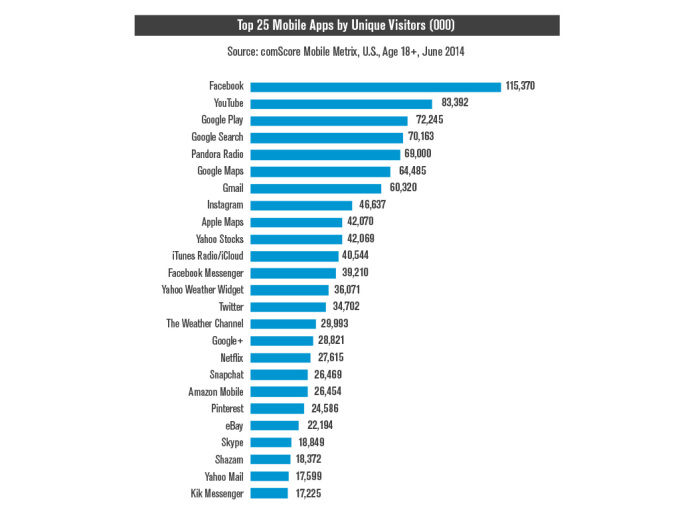
In Defense of the Mobile Web
The debate over the benefits of mobile apps versus mobile websites has raged for quite some time, and now it appears a winner has been declared. comScore has just released a study saying that US users now spend the majority of their time (52%) consuming digital media in mobile apps.
Because of this report and others like it, there is already a huge focus within content and media organizations on building their iPhone and Android apps. Unfortunately, given these companies’ limited development resources, this often means that their mobile/responsive websites suffer, which is a huge mistake.
Taking a look at the comScore data, Facebook is by far the most-used mobile app with over 115 million monthly users (counting only people over 18). Overall, Facebook, Google, Apple and Yahoo account for 12 out of the top 13 most used apps. Here is the list of the top 25:
Notably, there are no major content creation companies (e.g., ESPN, Buzzfeed, The New York Times, etc.) on this list. A much smaller number of people use those organizations’ apps. The reason is that instead, users routinely consume this type of content through the in-app browsers of the apps listed above. Clicking on a link in the Facebook or Twitter app brings users to content companies’ mobile websites.
Additionally, and maybe even more importantly, a huge amount of content sharing (particularly of mid- and long-tail content) still comes not through public methods (like social media) but rather through what’s been termed “dark social,” which is the direct sharing of content through email, texting, etc. When recipients of this shared content view it, they click on a link that someone has sent directly to them, which opens up a browser to access a website directly. This is significant: one study found that a whopping 71% of all content sharing still comes through dark social.
Similarly, there has been growth recently in the number of email newsletters, all of which contain numerous links that open browsers when users click on them. These newsletters have a 28% open rate on smartphones compared to an overall average open rate of 20%, and they provide important additional distribution for media companies’ content.
Finally, another benefit for organizations to consider as they plan their mobile product roadmap and priorities is that Google has publicly proclaimed that well-designed, responsive mobile sites receive improved SEO from their search algorithm.
Apps are obviously massively popular ways to consume information and content, but it’s important not to forget the browser layer inside those apps as well as the fact that a lot of people still share information directly with one another. Because of this, the mobile web is actually becoming an even more valuable tool for many companies than ever before.


